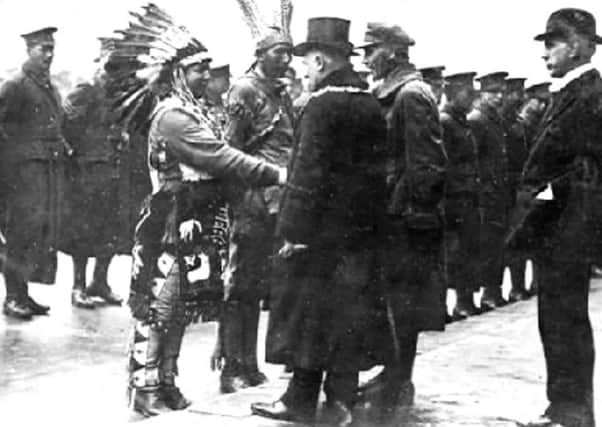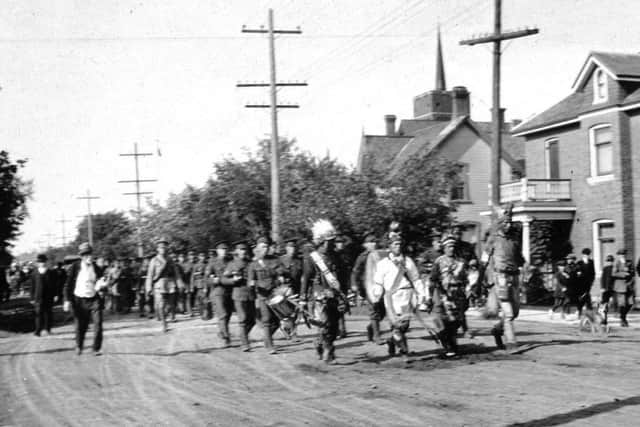Chief Clear Sky and his men made ultimate sacrifice at the Somme


The perceived wisdom of the time was that by crossing the great Atlantic our family would have new opportunities made available to us thus ensuring a better standard of living and health.
There was, of course, a great sense of adventure and romanticism about moving to a country with grizzly bears, wolves, beavers, very high mountains and enormous lakes, the Royal Canadian Mounted Police and “Red Indians”.
Advertisement
Hide AdAdvertisement
Hide AdBut now I cringe with embarrassment and feel a sense of outrage when I hear terms such as “Redskins”, “Red Indians”, “Indians” to describe the indigenous population, now correctly termed the First Nations Peoples of Canada.


The traditions and respect for the environment of the First Nations have long been a source of interest and wonderment to me. However, it was a chance remark that led me to inquire if there was substance to a story that claimed Canada’s First Nations First World War soldiers donated money to Scottish Great War veterans. What I eventually discovered was the little known history of a First Nations battalion in the Canadian Expeditionary Force, the 114th Haldimand Rifles, also known as Brock’s Rangers, and their war-time relationship with Scotland.
Most of the men in the Haldimand Rifles volunteered for war service in 1915 and the majority came from South Ontario on the Six Nations Reserve. The Iroquois Nation had a long history of loyalty to the Crown, fighting with the British in the Revolutionary War and they were allied with the British in the French and Indian Wars.
Yet in the early days of the Great War the Canadian Government questioned whether the First Nations could contribute anything to the war effort. In Ottawa, the seat of government, there was a reluctance to involve the native population. Surrounded in mythology if not prejudiced belief, “Red Indians”, as they were referred to in official memoranda, were associated with war-time practices that were incompatible with modern warfare, and it was asserted that the enemy might refuse to “extend to them the privileges of civilised warfare”. However, as the issue was discussed in the corridors of power, many First Nations men and boys had already made their way to recruitment offices and stations.
The Iroquois Reserves became active in their support of the war particularly around Brantford and Tyendinaga in Ontario, and they became the highest sources of Indian enlistment in Canada. Also, throughout Canada the First Nations established a Patriotic Fund and collected money for the war effort. On the Reserves, First Nations women raised money for the Canadian Red Cross and supplied homemade comforts for Canadian troops. By 1916, the First Nations were definitely part of the war effort.


Following their training at Camp Borden in Canada, the 114th arrived in Britain in October 1916 and were temporarily stationed in the south of England. Prior to deployment, the men asked permission to spend their furlough in Scotland. To Canadian and British Army officers this appeared to be an unusual request. Why did the First Nations soldiers want to travel to Scotland?
Since the time of the Highland Clearances, Scots have settled on land belonging to the Iroquois Confederacy and the town of Caledonia is an example. Ranald McKinnon, a Scottish engineer born on Mull, played a large part in the creation of the town. It is located on the Grand River in Haldimand County, Ontario, and the strength of the connection to Scotland is evidenced in street names such as Fife, Haddington, Argyle, Kinross, Stirling, Caithness and Elgin. However, it is particularly interesting that some of the surnames in the Haldimand First Nations Roll of enlistments are Scottish. It is unsurprising therefore that a contingent from the 114th Haldimand Rifles wanted to visit Scotland.
Advertisement
Hide AdAdvertisement
Hide AdIn December 1916, a total of 165 First Nations soldiers arrived in Scotland. The contingents arrived in Glasgow Central Station on the evening of 7 December and were met by civic dignitaries. The soldiers wore regulation khaki but their four chiefs wore ceremonial native dress. The contingents dined at the hospitality of Glasgow Corporation and were accommodated overnight in a hotel. The three-day visit to Glasgow included excursions to the Clyde shipyards, Glasgow Cathedral, the McLellan Galleries, a music hall and circus. The Lord Provost hosted a dinner at the Trades Hall and a special concert was held in their honour at the City Chambers.
On 11 December, the men departed from Glasgow for Edinburgh, and arrived into the Caledonian Station on the 12.15pm train. They were met by city officials and representatives of the Scottish-First Nations Alliance. The soldiers marched along Princes Street, turning off at the foot of the Mound, proceeding up towards the castle.
The men were led by Chief Clear Sky, Chief Silversmith, Chief Cook and Chief Hill. According to The Scotsman, the four chiefs “carried themselves with dignity and distinction”. The article also stated “the majority of the contingent is Iroquois, who are amongst the finest and best known of the race. The Six Nations forming the Iroquois Confederacy are the descendants of the fifty noble families who composed the historic association founded by Hiawatha over 400 years ago. They are renowned for their astuteness, brain power and capacity”. The newspaper further reported that the visitors “were cordially hailed by the residents of the Scottish capital, wherever they appeared, as fellow citizens of the Empire”.
On arrival at the castle, the men signed the visitors’ book, and Chief Clear Sky pointed out to his men the name of Lord Kitchener on one of the pages. It emerged that Chief Clear Sky had a great interest in Scottish history and was knowledgeable about the history of the castle. He was a former pupil of the Carlisle Institute and graduated with archaeology and history being two of his subjects.
After their tour of the castle, a special luncheon was held there, hosted by Lord Provost Lorne MacLeod, who, in his speech to the men, conveyed a hearty welcome to the capital city. The men were taken to the King’s Theatre for an evening’s entertainment. On the conclusion of the performance, Chief Clear Sky delivered a patriotic speech to the audience.
The men were taken with the kindness of the Scottish people and before they left Edinburgh they took up a collection amongst themselves and donated the money to the Scottish Red Cross. However, the warmth of their Scottish experience lingered, and for those who survived the war and returned to the Reserves, they organised fund-raising activities in support of Scottish veterans. The money was specifically donated towards building much needed veterans’ houses, and today they are still in use and occupied by veterans.
This hidden history of our relationship with the First Nations will be highlighted in an exhibition which I am taking to Canada this month. In the Haldimand Museum, the story of their visit to Scotland will be told for the first time. It is also anticipated that descendants of the men who came to Scotland will be present at the exhibition launch.
Advertisement
Hide AdAdvertisement
Hide AdOn 7 December, 100 years to the day after their arrival in Scotland, I will be in the Cultural Centre of the Six Nations Reserve presenting First Nations representatives with two beautiful, hand-made, quilted panels, depicting their visit to Scotland, and incorporating images of the veterans’ houses. Ladies from the Milton Quilters in Edinburgh have done their story and humanity proud.
The First Nations soldiers in the Haldimand Rifles were part of the 4,000 native volunteers from Canada who joined the Allies during the Great War. In a statement issued from the Canadian Department of Veterans’ Affairs, it was claimed that First Nations men served with “great distinction, many of them receiving military awards for bravery in the field and approximately 500 died as a direct result of their war service”.
The citation could have also included that they epitomised the meaning of brothers- in-arms, and for the Scottish veterans who benefited from their generosity of spirit, they were truly blood brothers.
• Dr Yvonne McEwan is an Outreach Officer at the University of Edinburgh. Blood Brothers and Brothers in Arms banner exhibition is on display in Central Library, Edinburgh